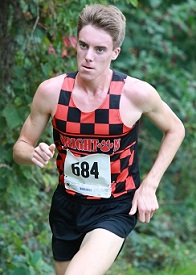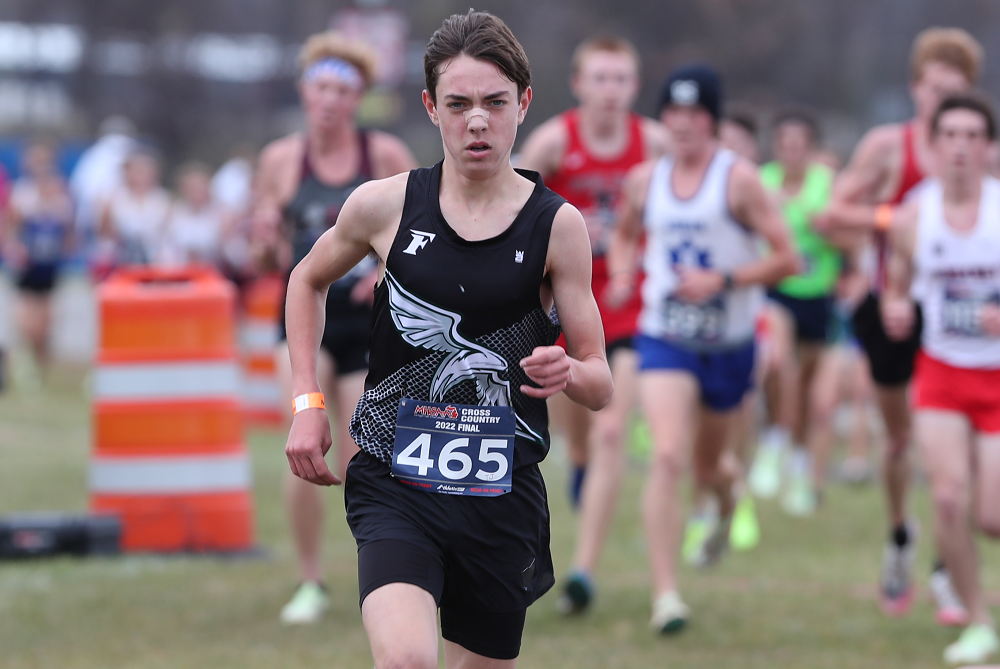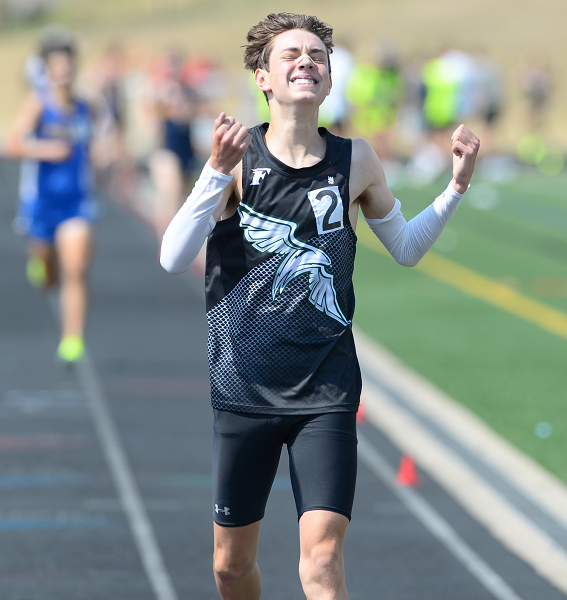
Performance: Brighton's Jack Spamer
October 18, 2019
 Jack Spamer
Jack Spamer
Brighton senior – Cross Country
The Bulldogs distance ace posted Michigan’s fastest high school time since 2014 with a 14:48.1 to finish first at the 35th Ann Arbor Father Gabriel Richard Invitational on Oct. 12. He cut 14 seconds from his personal record run from a week before and cleared the field by 22 seconds, earning the MHSAA “Performance of the Week.”
Spamer was a strong competitor last season, finishing 18th at the Lower Peninsula Division 1 Final at Michigan International Speedway after coming in 48th as a sophomore. He’s taken another significant jump this fall, finishing first or second in all but one event – when he took third in the Elite race at the Sept. 13 Spartan Invitational at Michigan State University. Running against many of the state’s best again at the Portage Invitational on Oct. 5, Spamer cut 30 seconds off his previous season-best time with a 15:02. That set the stage for last weekend’s awe-inspiring run, the fastest in the state since former Grand Blanc speedster (and eventual 12-time Stanford All-American) Grant Fisher posted a 14:43 at Portage in 2014.
Talent and hard work have delivered Spamer’s improvement, of course – but credit also should go to his competition in the Kensington Lakes Activities Association, including teammate Zachary Stewart and Plymouth senior Carter Solomon, last season’s LPD1 Final runner-up. Spamer finished second to Solomon at Thursday’s KLAA finals, where five runners cleared 15:24. Brighton won the team championship at the league meet and is ranked No. 1 in LPD1 as it pursues a first MHSAA Finals championship since 1995. Spamer is hoping for a similar jump next spring on the track as he’ll look to improve on a ninth place in the 1,600 and 11th in the 3,200 from this past June’s LPD1 Finals. While he surely has a future in racing, academics will provide plenty of opportunities as well. Spamer carries a 3.95 grade-point average and is interested in studying computer science or computer engineering as he considers his next destination after high school.
Coach Chris Elsey said: “Jack has been a tremendous inspiration to his teammates. He is the perfect model to show what can be accomplished with a lot of hard work and dedication. As a freshman he couldn't crack the varsity lineup, and now he's one of the top runners in the state. Jack is extremely coachable. He responds positively to both praise and critiques, and he is always looking for ways to improve the team. Jack is an excellent teammate. The team's goals are always first, and he is most excited to see the breakthrough performances of his younger teammates. Jack is a great leader. His demeanor and work ethic at practices, meets, and in the classroom show his peers how to do things the right way every day. He has been a pleasure to coach these four years, and I'm looking forward to seeing what the rest of this season has in store.”
Performance Point: “The first mile was really fast, and after that I was just trying to keep that same pace,” Spamer said of his Gabriel Richard race. “I knew I was definitely pushing it a lot more than usual. We didn't have splits at the second or third mile, so I was hoping that I was going at a pace where I was going to break 15. It definitely felt different than previous races. The weather was the best you could ever have for running that morning. The course was fantastic and super flat and great for PR'ing (setting a personal record). ... When you have an opportunity like that to run that fast, it's a really good opportunity to take because generally cross country weather isn't as good as you hope it (will be). Taking advantage of the conditions really helped me to break 15 minutes.”
 Dropping time: “Mainly it's just training in the offseason and just working toward goals that we had set. I have such a great coach that he was able to dedicate his time not just during the season but in the offseason to continue to train us so we're the best that we can be. So just that and the fact that I've been able to have goals to work for, and setting those has helped me get to where I am now – massive improvements from last season.”
Dropping time: “Mainly it's just training in the offseason and just working toward goals that we had set. I have such a great coach that he was able to dedicate his time not just during the season but in the offseason to continue to train us so we're the best that we can be. So just that and the fact that I've been able to have goals to work for, and setting those has helped me get to where I am now – massive improvements from last season.”
Eye on No. 1: “Going into this season my goal was low 15s. But then after Portage, and that was a really big breakout race for me, I knew I definitely had the capability to go even faster. … From aiming for top five in the state, now my goal is pretty much just state champ. Being able to have confidence going into meets in the championship season knowing that you can compete with some of the best guys that are out there, I changed my mindset and now I just know that if the better guys are racing at one pace, I know that I can probably race at the same pace. Going into races with that kind of confidence definitely helps a lot.”
Rivals get us ready: “Being able to have so much great competition in the dual meets that you do during the regular season, you just gain so much experience out of that – especially running against kids that you're going to be running against at some of the biggest meets. Being able to race (Solomon and others) now definitely helps so when you're going into the other meets you're like, ‘OK, I've raced them. I know how they race.’ It's just another confidence builder. When you're running a 5K race, it definitely helps to have a lot of confidence. … We're really cool (with each other). As much as it's fun to compete with them on the course, everyone is great people off the course. We all just kind of talk and joke to each other and stuff. We're all great friends.”
This computes: “I've always been interested in computers and stuff like that since I was little. It's something I'd love to learn more about. Probably stuff to do with coding most likely, or if I look at the computer engineering route building circuits and stuff for computers and components. I'm definitely more of a math and science kind of guy than English.”
– Geoff Kimmerly, Second Half editor
Past honorees
Oct. 10: Kaylee Maat, Hudsonville volleyball - Report
Oct. 3: Emily Paupore, Negaunee cross country - Report
Sept. 26: Josh Mason, South Lyon soccer - Report
Sept. 19: Ariel Chang, Utica Eisenhower golf - Report
Sept. 12: Jordyn Shipps, DeWitt swimming - Report
PHOTOS: (Top) Brighton's Jack Spamer leads the pack at Kensington Metropark on the way to winning the Averill Invitational on Sept. 7. (Middle) Spamer climbs a hill during a meet against Canton and Novi. (Photos courtesy of the Brighton cross country programs.)

Freeland's Hansen Not Focused on Joining All-Time Greats - But On His Way
By
Paul Costanzo
Special for MHSAA.com
September 29, 2023
The goal written on Matt Kaczor’s Post-It Note was sub-15 minutes, 15 seconds. That’s what the Freeland cross country coach was hoping for from star runner TJ Hansen during his junior season.
 Kaczor tore it up after seeing Hansen run a single race this fall.
Kaczor tore it up after seeing Hansen run a single race this fall.
“Knowing what he did over the summer and where he was at, seeing what his 1,600 (meter) and his mile got down to, I had a feeling he could get under 15:30 quickly,” Kaczor said. “After the first race, I looked at my assistant and was like, ‘I’ve gotta rip up that Post-It Note. I don’t think our goal is on the level of where he’s at right now.’ At first, it was break 15:15. Once I saw him race at the Under the Lights (on Aug. 18 at St. Johns), I was like, ‘Yeah, he’s going sub 15.’”
Hansen ran 15:39.6 in that first race, and on Sept. 7, in Shepherd, he ran 15:13.9 to meet the goal written on the now-shredded Post-It Note.
This past Saturday, he ran 15:03.7 at the Cadillac Veterans Serving Veterans Invitational. It’s the fastest time recorded in Michigan this year, and a signal that Kaczor might be filling out a new Post-It Note before the season is out.
“The sub-15 barrier, that’s been something on my mind for a while,” Hansen said. “Now that I’m edging closer and closer to that, it’s been exciting. With how heavy my training has been, I wouldn’t expect (to have run this fast this early). Being able to run the times I am really paints the picture for what’s ahead.”
Hansen came into the season already regarded as one of the elite distance runners in the state. He won the 3,200 meters at the MHSAA Lower Peninsula Division 2 Track & Field Finals this past spring. He’s also finished all-state (12th and fifth, respectively) the past two seasons at the LPD2 Cross Country Finals.
His current trajectory, however, would put his name near some of the state’s all-time greats. But that’s not something Hansen is focusing on.
“I really don’t like to compare myself to others,” he said. “I don’t focus on that. I try to be the best TJ Hansen that I can be. The best version of myself.”
Focusing on himself is almost necessary for Hansen, as he’s spending a lot of time during his races running by himself.
At each of the big events Freeland has run in this season, Hansen has finished at least 20 seconds ahead of his nearest competitor. That includes all divisions of the Duane Raffin Festival of Races in Holly.
In Cadillac, where Hansen ran his current best time, he was a full minute ahead of the rest of the field.
 “He’s just a special athlete,” Kaczor said. “I can’t see Freeland having someone like this in a while. He’s a generational talent. What’s crazy is, I had the school record when he was a freshman. He and Braden (Honsinger) broke it last year. But TJ has now dropped that school record (set in 1998) by almost a minute.”
“He’s just a special athlete,” Kaczor said. “I can’t see Freeland having someone like this in a while. He’s a generational talent. What’s crazy is, I had the school record when he was a freshman. He and Braden (Honsinger) broke it last year. But TJ has now dropped that school record (set in 1998) by almost a minute.”
Hansen’s achievements have already put him on a path to run at the next level, which is something of a family tradition.
His older sisters Peyton and Kiera are track & field athletes at Wayne State and Eastern Michigan, respectively. Their parents, Tim and Pam, were track & field stars at Central Michigan.
TJ has drawn the attention of coaches around the country, including from Michigan, Michigan State, Wisconsin, Tennessee and Colorado.
Having family members who know the process is a help for Hansen, and he said they’ve all been good about allowing him to choose his own path, whatever that may be.
“He’s from a good family that knows how to work and knows how to get things done,” Kaczor said. “He knows that if he puts in the work, he’s going to be at a good spot.”
While Hansen admits it can be a bit overwhelming, he’s using it as motivation to run faster and continue to put his name out there.
Also serving as motivation is 2022 Division 2 champion Connell Alford of Chelsea. Alford is among the elite group of runners in Michigan who have broken the 15-minute mark, doing it twice a year ago.
He currently has the state’s second-best time behind Hansen’s this year, running 15:09.1 at the MSU Invitational on Sept. 15.
“Whenever I see him drop a time, my main goal is to run faster,” Hansen said. “Whenever I see him run a good time, that motivates me to work hard.”
The two won’t see each other until the MHSAA Finals on Nov. 4 at Michigan International Speedway. It’s an opportunity Hansen is excited for, as it’s a chance to race and be pushed toward the lofty goals he’s set for himself. Kaczor is excited about it, too, even if it might mean having to replenish his supply of Post-Its.
“We don’t talk about winning the state title; we talk about making sure that we have great races on those days,” Kaczor said. “We can’t control how somebody else runs. It’s a matter of can we, if the weather is right and the course is in good condition, can we be one of the few guys that has run in the 14s on that course? That’s the goal. Put yourself in some great categories with those upper echelons and the greats of all-time.”
 Paul Costanzo served as a sportswriter at The Port Huron Times Herald from 2006-15, including three years as lead sportswriter, and prior to that as sports editor at the Hillsdale Daily News from 2005-06. He can be reached at [email protected] with story ideas for Genesee, Lapeer, St. Clair, Sanilac, Huron, Tuscola, Saginaw, Bay, Arenac, Midland and Gladwin counties.
Paul Costanzo served as a sportswriter at The Port Huron Times Herald from 2006-15, including three years as lead sportswriter, and prior to that as sports editor at the Hillsdale Daily News from 2005-06. He can be reached at [email protected] with story ideas for Genesee, Lapeer, St. Clair, Sanilac, Huron, Tuscola, Saginaw, Bay, Arenac, Midland and Gladwin counties.
PHOTOS (Top) Freeland's TJ Hansen leads a pack during last season's LPD2 Final at Michigan International Speedway. (Middle) Hansen enjoys a moment of exhilaration after winning the 3,200 this spring at the LPD2 Finals at Ada Forest Hills Eastern. (Top photo by Carter Sherline/Run Michigan; middle photo by Dave McCauley/Run Michigan.)

